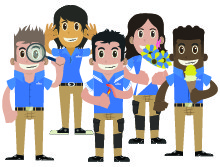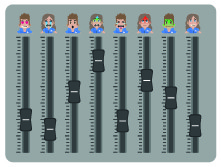So how do you go about creating a realistic training environment? What's needed?
FireWare can offer a tried and tested concept for this. Would you like to know more about our philosophy regarding realistic staging? And how we can ensure your students constantly improve?

Senses

Control of the senses

Learning, lesson and training objectives

Scenario

Decor
FireWare bases realistic staging on 5 pillars:
We work according to the assumption that people perceive things through their senses. The five senses defined by Aristotle are used as a basis for this:
We can see
We can hear
We can smell
We can taste
We can feel
New insights regarding extrasensory perception have developed during the course of time, as "Aristotle's 5" didn't appear to be exhaustive. Dependent on the definition of a sense used, some scientists claim that people have 5, 7, 9, 11 or sometimes even 33 senses. It's therefore perfectly sensible to dedicate a separate study to this.
We have worked with a selection of "usable" senses in order to create a realistic training environment within FireWare, which serve to complement Aristotle's 5:
We have a sense of balance
We can distinguish between hot and cold (thermoception)
We are aware of our bodies (nociception)
We can feel pain (proprioception)
Why are these senses so important? This is because we are working according to the following assumption:
"Realistic training means to stimulate every sense as realistically as possible"
For example, with a fire scenario we will ensure everything looks as real as possible, everything sounds as real as possible, plus everything smells and feels as real as possible.
A minor marginal note here:
Not every sensory perception is of equal importance during every type of training or simulation. For example, balance will have a different value in simulations in the shipping or aviation industry compared to natural fire simulations.
Simulations involving compressed air will assign a different value to our sense of smell compared to simulations without compressed air. How much each sense is addressed will be partly dependent on the training objectives.
"If all our senses are stimulated as realistically as possible during realistic staging, then where is the difference with reality?" After all, there is nothing quite as real as locking a person in a house, setting fire to this house and subsequently seeing what you can do to help... And yet everyone knows this isn't a desirable training situation.
According to our philosophy, this has got everything to do with control.
We want to be able to stimulate all the senses in a controlled, parameterised and safe manner during an exercise or simulation. This has many different advantages:
A training situation will remain safe
Training situations will be varied: several different training possibilities will be created by being able to influence several parameters.
Various different training levels are possible: the student is given space to grow and develop.
There is an option to train per sense or group of senses.
Training exercises can be repeated, ensuring every student can have the same experience.
Dynamic staging becomes a possibility. Time and pace are under control.
This stimulating of the senses is achieved, for example, through the use of staging materials. Good staging materials will result in the stimulation of at least one sense.
The interplay of staging materials and good control possibilities for these staging materials will eventually ensure as many senses as possible are addressed in a controlled manner.
It's very important to clearly formulate the learning, lesson and training objectives before designing staging, a training centre or simulator. It's impossible to realise a good training situation without this information.
Yet in practice we have seen this subject isn't always given the attention it deserves. After all, there's a great deal more involved than simply ticking off an Excel list with goals. Goals are important. But a good simulation will always allow room or scope for the development of:
The student's knowledge level (knowing what to do)
The student's skills (knowing how to do something)
The student's attitude (knowing why)
Naturally dependent on the chosen didactic model, it's important to be able to influence the scenario in order to allow for this development. This can be achieved, for example, by creating:
- dilemmas
- scarcity or abundance
- unexpected twists
- time pressure
- psychological pressure
- social pressure
How and when and subject to which conditions these parameters can be influenced forms an essential part of the preparations. Working on the development of knowledge and attitude in addition to the development of skills is characteristic of FireWare's methods. "Staging is always used to support the set training and learning objectives!" It goes without saying that a good evaluation method, whether or not with the use of tools or other aids, represents an important part of the simulation.
Completing an exercise has many similarities with a theatre performance. You can have the absolute best actors in the world, the most fantastic spotlights, loudspeakers, special effects, costumes and decors... But it will be very difficult to put together a spectacular show if your story isn't quite right. However, if you have a good scenario, good actors and the best theatre technical facilities in place: you will certainly have a major chance of the show becoming a huge success and that everyone from around the world will want to come and watch the show (or training exercise)!
In many cases it will come down to creating a decor which is as realistic as possible. Both the exterior and the interior will be designed in such a way that it approaches reality. This recognition of rooms or spaces, buildings and objects will positively contribute to the training experience. It goes without saying that it will be of the utmost importance to look at how the areas or rooms are being used. Glass vases in a room used for domestic violence scenarios are probably not the best idea.
The training objects (and the synergy between the various different training objects) must benefit both the training objectives as well as the scenario! The use of mobile staging materials means it's very possible to train at a real location instead of at a training centre. This will result in an inexhaustible source of training objects. For example, the training could take place in a real factory in town.
Take a look at the inspiration portfolio wat to see all the possibilities.... In short, a good decor will result in:
Support for the lesson and learning objectives
Support for the scenario
Possibilities for realistic, controlled stimulation of all the senses
A good training experience
It's evident from this summary that a decor doesn't always need to take on a realistic appearance, in order to create a realistic training environment. This allows scope for the use of different game forms, multimedia shows, skills trainers and a number of other concepts whereby senses are still being stimulated in a controller manner. Based on a good scenario in relation to training objectives, in a suitable decor. This method is also evident within the theatre world.
The use of abstraction can produce beautiful and challenging decors. Perfect for telling a beautiful story. This method is often used in amusement parks. After all, people are really prepared to travel a long way for that experience and will be talking about this for many years to come!






